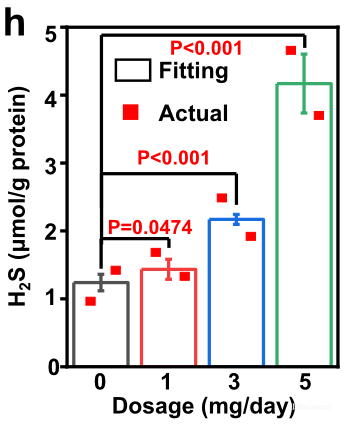H2S Colorimetric Assay Kit
SKU: E-BC-K355-M-96
H2S Colorimetric Assay Kit
| SKU # | E-BC-K355-M |
| Detection Instrument | Microplate reader (660-670 nm, optimum wavelength: 665 nm) |
| Detection method | Colorimetric method |
Product Details
Properties
| Synonyms | H2S |
| Sample type | Serum, plasma, animal tissue |
| Sensitivity | 2.75 μmol/L |
| Detection range | 4.86-100 μmol/L |
| Detection Method | Colorimetric method |
| Assay type | Quantitative |
| Assay time | 80 min |
| Precision | Average inter-assay CV: 9.900% | Average intra-assay CV: 3.100% |
| Other instruments required | Micropipettor, Centrifuge, Incubator, Vortex mixer |
| Other reagents required | Normal saline (0.9% NaCl) |
| Storage | 2-8℃ |
| Valid period | 12 months |
Images
Y Q Zhang et al developed a hydrogen sulphide-responsive and depleting nanoplatform for cancer photodynamic therapy. H2S level in cell was determined using H2S colorimetric assay kit (E-BC-K355-M).

H2S level in cell is significantly increased by dosage.
Dilution of Sample
It is recommended to take 2~3 samples with expected large difference to do pre-experiment before formal experiment and dilute the sample according to the result of the pre-experiment and the detection range (6.82-100 μmol/L).
The recommended dilution factor for different samples is as follows (for reference only):
| Sample type | Dilution factor |
| Human plasma | 1 |
| Mouse plasma | 1 |
| 10% Rat spleen tissue homogenate | 1 |
| 10% Rat kidney tissue homogenate | 1 |
| 10% Rat brain tissue homogenate | 1 |
Note: The diluent is normal saline (0.9% NaCl).
Detection Principle
H2S can react with acetate solution to form ZnS which can be dissolved in alkaline solution. In the presence of Fe3+, methylene blue can be formed. Methylene blue has a maximum absorption peak at 665 nm. H2S content can be calculated indirectly by measuring the OD value at 665 nm.
Kit Components & Storage
| Item | Component | Size 1 (48 T) | Size 2 (96 T) | Storage |
| Reagent 1 | Buffer Solution | 13 mL × 1 vial | 25 mL × 1 vial | 2-8°C, 12 months |
| Reagent 2 | Alkali Reagent | 7 mL × 1 vial | 13 mL × 1 vial | 2-8°C, 12 months |
| Reagent 3 | Chromogenic Agent | 7 mL × 1 vial | 13 mL × 1 vial | 2-8°C, 12 months shading light |
| Reagent 4 | Protein Precipitator | 7 mL × 1 vial | 13 mL × 1 vial | 2-8°C, 12 months |
| Reagent 5 | Ferric Salt Reagent | 2 mL × 1 vial | 2 mL × 1 vial | 2-8°C, 12 months shading light |
| Reagent 6 | Standard | 7.8 mg × 1 vial | 7.8 mg × 1 vial | 2-8°C, 12 months shading light |
| Reagent 7 | Standard Diluent | 60 mL × 2 vials | 60 mL × 2 vials | 2-8°C, 12 months |
| Microplate | 96 wells | No requirement | ||
| Plate Sealer | 2 pieces | |||
Note: The reagents must be stored strictly according to the preservation conditions in the above table. The reagents in different kits cannot be mixed with each other. For a small volume of reagents, please centrifuge before use, so as not to obtain sufficient amount of reagents.
Technical Data:
Parameter:
Intra-assay Precision
Three human serum samples were assayed in replicates of 20 to determine precision within an assay. (CV = Coefficient of Variation)
| Parameters | Sample 1 | Sample 2 | Sample 3 |
| Mean (μmol/L) | 12.50 | 35.60 | 84.20 |
| %CV | 3.5 | 3.2 | 2.6 |
Inter-assay Precision
Three human serum samples were assayed 17 times in duplicate by three operators to determine precision between assays.
| Parameters | Sample 1 | Sample 2 | Sample 3 |
| Mean (μmol/L) | 12.50 | 35.60 | 84.20 |
| %CV | 9.5 | 10.4 | 9.8 |
Recovery
Take three samples of high concentration, middle concentration and low concentration to test the samples of each concentration for 6 times parallelly to get the average recovery rate of 94%.
| Standard 1 | Standard 2 | Standard 3 | |
| Expected Conc. (μmol/L) | 18.6 | 37.3 | 75 |
| Observed Conc. (μmol/L) | 18.4 | 35.1 | 66.8 |
| Recovery rate (%) | 99 | 94 | 89 |
Sensitivity
The analytical sensitivity of the assay is 2.75 μmol/L. This was determined by adding two standard deviations to the mean O.D. obtained when the zero standard was assayed 20 times, and calculating the corresponding concentration.
Standard Curve
As the OD value of the standard curve may vary according to the conditions of the actual assay performance (e.g. operator, pipetting technique or temperature effects), so the standard curve and data are provided as below for reference only:
| Concentration (μmol/L) | 0 | 10 | 20 | 30 | 40 | 60 | 80 | 100 |
| OD value | 0.083 | 0.113 | 0.152 | 0.195 | 0.245 | 0.363 | 0.460 | 0.548 |
| 0.084 | 0.116 | 0.157 | 0.200 | 0.253 | 0.359 | 0.453 | 0.567 | |
| Average OD | 0.084 | 0.115 | 0.155 | 0.198 | 0.249 | 0.361 | 0.456 | 0.558 |
| Absoluted OD | 0.000 | 0.031 | 0.071 | 0.114 | 0.165 | 0.277 | 0.372 | 0.474 |



